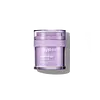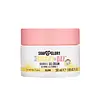What's inside
What's inside
 Key Ingredients
Key Ingredients

 Benefits
Benefits

 Concerns
Concerns

 Ingredients Side-by-side
Ingredients Side-by-side

Water
Skin ConditioningGlycerin
HumectantTetrahexyldecyl Ascorbate
AntioxidantDimethicone
EmollientPolyacrylamide
4-Butylresorcinol
AntioxidantHexapeptide-2
BleachingAllantoin
Skin ConditioningHydrolyzed Brassica Napus Seedcake Extract
Skin ConditioningTremella Fuciformis Sporocarp Extract
AntioxidantSqualane
EmollientDipotassium Glycyrrhizate
HumectantPentylene Glycol
Skin ConditioningButylene Glycol
HumectantDimethicone Crosspolymer
Emulsion StabilisingC13-14 Isoparaffin
EmollientCeramide NP
Skin ConditioningCeramide AP
Skin ConditioningCeramide EOP
Skin ConditioningLinoleic Acid
CleansingLinolenic Acid
CleansingPhytosphingosine
Skin ConditioningCholesterol
EmollientSodium Lauroyl Lactylate
EmulsifyingXanthan Gum
EmulsifyingCarbomer
Emulsion StabilisingCetearyl Olivate
Sorbitan Olivate
EmulsifyingLaureth-7
EmulsifyingCaprylyl Glycol
EmollientHexylene Glycol
EmulsifyingEthylhexylglycerin
Skin ConditioningPhenoxyethanol
PreservativeWater, Glycerin, Tetrahexyldecyl Ascorbate, Dimethicone, Polyacrylamide, 4-Butylresorcinol, Hexapeptide-2, Allantoin, Hydrolyzed Brassica Napus Seedcake Extract, Tremella Fuciformis Sporocarp Extract, Squalane, Dipotassium Glycyrrhizate, Pentylene Glycol, Butylene Glycol, Dimethicone Crosspolymer, C13-14 Isoparaffin, Ceramide NP, Ceramide AP, Ceramide EOP, Linoleic Acid, Linolenic Acid, Phytosphingosine, Cholesterol, Sodium Lauroyl Lactylate, Xanthan Gum, Carbomer, Cetearyl Olivate, Sorbitan Olivate, Laureth-7, Caprylyl Glycol, Hexylene Glycol, Ethylhexylglycerin, Phenoxyethanol
Water
Skin ConditioningGlycerin
HumectantCaprylic/Capric Triglyceride
MaskingCetearyl Alcohol
EmollientButyrospermum Parkii Butter
Skin ConditioningDimethicone
EmollientPolyacrylamide
Phenoxyethanol
PreservativeSteareth-2
EmulsifyingSteareth-21
CleansingC13-14 Isoparaffin
EmollientChlorphenesin
AntimicrobialAscorbyl Tetraisopalmitate
AntioxidantLaureth-7
Emulsifying3-O-Ethyl Ascorbic Acid
Skin ConditioningBHT
AntioxidantSodium Citrate
BufferingLimonene
PerfumingDipropylene Glycol
HumectantCitric Acid
BufferingPropylene Glycol
HumectantAlcohol Denat.
AntimicrobialParfum
MaskingBenzotriazolyl Dodecyl P-Cresol
UV AbsorberLinalool
PerfumingGlycine Soja Oil
EmollientLecithin
EmollientAlcohol
AntimicrobialTris(Tetramethylhydroxypiperidinol)Citrate
StabilisingCaprylyl Glycol
EmollientXanthan Gum
EmulsifyingPotassium Sorbate
PreservativeUbiquinone
AntioxidantCarrageenan
CI 14700
Cosmetic ColorantCI 15985
Cosmetic ColorantCI 19140
Cosmetic ColorantWater, Glycerin, Caprylic/Capric Triglyceride, Cetearyl Alcohol, Butyrospermum Parkii Butter, Dimethicone, Polyacrylamide, Phenoxyethanol, Steareth-2, Steareth-21, C13-14 Isoparaffin, Chlorphenesin, Ascorbyl Tetraisopalmitate, Laureth-7, 3-O-Ethyl Ascorbic Acid, BHT, Sodium Citrate, Limonene, Dipropylene Glycol, Citric Acid, Propylene Glycol, Alcohol Denat., Parfum, Benzotriazolyl Dodecyl P-Cresol, Linalool, Glycine Soja Oil, Lecithin, Alcohol, Tris(Tetramethylhydroxypiperidinol)Citrate, Caprylyl Glycol, Xanthan Gum, Potassium Sorbate, Ubiquinone, Carrageenan, CI 14700, CI 15985, CI 19140
Ingredients Explained
These ingredients are found in both products.
Ingredients higher up in an ingredient list are typically present in a larger amount.
This ingredient is also known as "C13-14 Isoalkane".
C13-14 Isoparaffin is created from petroleum-based mineral oils. It is an emollient and helps thicken a product.
As an emollient, it helps keep the skin soft and smooth by creating a barrier on top. This barrier traps moisture in, keeping the skin hydrated.
C13-14 Isoparaffin may not be fungal-acne safe.
Learn more about C13-14 IsoparaffinCaprylyl Glycol is a humectant and emollient, meaning it attracts and preserves moisture.
It is a common ingredient in many products, especially those designed to hydrate skin. The primary benefits are retaining moisture, skin softening, and promoting a healthy skin barrier.
Though Caprylyl Glycol is an alcohol derived from fatty acids, it is not the kind that can dry out skin.
This ingredient is also used as a preservative to extend the life of products. It has slight antimicrobial properties.
Learn more about Caprylyl GlycolDimethicone is a type of synthetic silicone created from natural materials such as quartz.
What it does:
Dimethicone comes in different viscosities:
Depending on the viscosity, dimethicone has different properties.
Ingredients lists don't always show which type is used, so we recommend reaching out to the brand if you have questions about the viscosity.
This ingredient is unlikely to cause irritation because it does not get absorbed into skin. However, people with silicone allergies should be careful about using this ingredient.
Note: Dimethicone may contribute to pilling. This is because it is not oil or water soluble, so pilling may occur when layered with products. When mixed with heavy oils in a formula, the outcome is also quite greasy.
Learn more about DimethiconeGlycerin is already naturally found in your skin. It helps moisturize and protect your skin.
A study from 2016 found glycerin to be more effective as a humectant than AHAs and hyaluronic acid.
As a humectant, it helps the skin stay hydrated by pulling moisture to your skin. The low molecular weight of glycerin allows it to pull moisture into the deeper layers of your skin.
Hydrated skin improves your skin barrier; Your skin barrier helps protect against irritants and bacteria.
Glycerin has also been found to have antimicrobial and antiviral properties. Due to these properties, glycerin is often used in wound and burn treatments.
In cosmetics, glycerin is usually derived from plants such as soybean or palm. However, it can also be sourced from animals, such as tallow or animal fat.
This ingredient is organic, colorless, odorless, and non-toxic.
Glycerin is the name for this ingredient in American English. British English uses Glycerol/Glycerine.
Learn more about GlycerinLaureth-7 is created by the ethoxylation of lauryl alcohol using ethylene oxide. Lauryl alcohol is a fatty alcohol with hydrating properties.
This ingredient is an emulsifier and cleansing ingredient. As an emulsifier, it is used to prevent ingredients from separating. It also helps cleanse the skin by gathering dirt, oil, and pollutants to be rinsed away.
Phenoxyethanol is a preservative that has germicide, antimicrobial, and aromatic properties. Studies show that phenoxyethanol can prevent microbial growth. By itself, it has a scent that is similar to that of a rose.
It's often used in formulations along with Caprylyl Glycol to preserve the shelf life of products.
Polyacrylamide is a synthetic polymer. It is used to stabilize products and bind ingredients. When hydrated, Polyacrylamide forms a soft gel.
Polyacrylamide is low-toxicity. If source properly, it is deemed safe to use in cosmetics.
It should be noted the precursor to Polyacrylamide is acrylamide. Acrylamide is a carcinogen. Most reputable sources of Polyacrylamide will screen for residual acrylamide to make sure the count is in a safe range. Acrylamide is not able to be absorbed through the skin.
We recommend speaking with a professional if you have concerns.
Learn more about PolyacrylamideWater. It's the most common cosmetic ingredient of all. You'll usually see it at the top of ingredient lists, meaning that it makes up the largest part of the product.
So why is it so popular? Water most often acts as a solvent - this means that it helps dissolve other ingredients into the formulation.
You'll also recognize water as that liquid we all need to stay alive. If you see this, drink a glass of water. Stay hydrated!
Learn more about WaterXanthan gum is used as a stabilizer and thickener within cosmetic products. It helps give products a sticky, thick feeling - preventing them from being too runny.
On the technical side of things, xanthan gum is a polysaccharide - a combination consisting of multiple sugar molecules bonded together.
Xanthan gum is a pretty common and great ingredient. It is a natural, non-toxic, non-irritating ingredient that is also commonly used in food products.
Learn more about Xanthan Gum